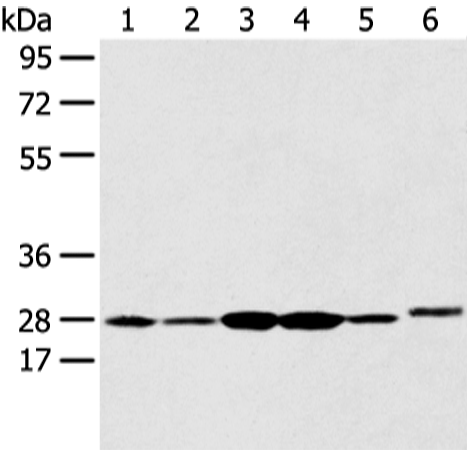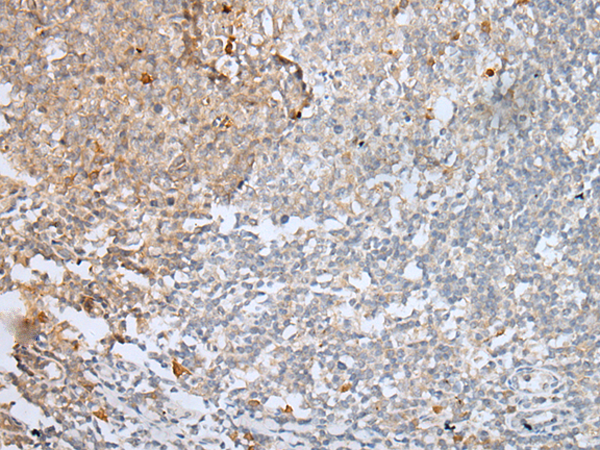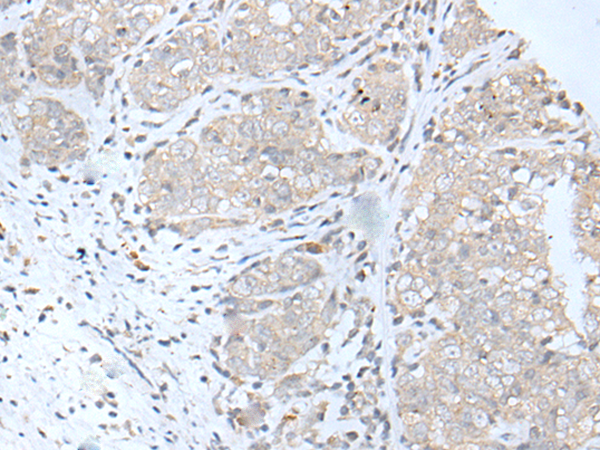


| WB | 咨询技术 | Human,Mouse,Rat |
| IF | 咨询技术 | Human,Mouse,Rat |
| IHC | 1/20-1/100 | Human,Mouse,Rat |
| ICC | 技术咨询 | Human,Mouse,Rat |
| FCM | 咨询技术 | Human,Mouse,Rat |
| Elisa | 1/5000-1/10000 | Human,Mouse,Rat |
| Aliases | PRX-4; AOE372; AOE37-2; HEL-S-97n |
| WB Predicted band size | 30 kDa |
| Host/Isotype | Rabbit IgG |
| Antibody Type | Primary antibody |
| Storage | Store at 4°C short term. Aliquot and store at -20°C long term. Avoid freeze/thaw cycles. |
| Species Reactivity | Human, Mouse, Rat |
| Immunogen | Synthetic peptide of human PRDX4 |
| Formulation | Purified antibody in PBS with 0.05% sodium azide and 50% glycerol. |
+ +
以下是关于PRDX4抗体的3篇代表性文献,内容涵盖功能研究、疾病关联及抗体应用方向:
1. **文献名称**: *"Peroxiredoxin 4 suppresses anoikis and promotes tumorigenesis in hepatocellular carcinoma"*
**作者**: Wei et al. (2018)
**摘要**: 研究通过PRDX4抗体检测肝癌组织中PRDX4蛋白表达,发现其高表达与肿瘤转移和不良预后相关。实验表明PRDX4通过抑制氧化应激保护细胞失巢凋亡(anoikis),促进肝癌进展。
2. **文献名称**: *"A novel monoclonal antibody against human peroxiredoxin 4 for immunoblotting and immunohistochemical analysis"*
**作者**: Yamaguchi et al. (2015)
**摘要**: 报道了一种特异性识别PRDX4的单克隆抗体的开发与验证,证实其在Western blot和免疫组化中的高灵敏度和特异性,为PRDX4在组织中的定位和定量分析提供可靠工具。
3. **文献名称**: *"PRDX4 interacts with insulin-like growth factor 1 receptor to regulate neuronal oxidative stress and apoptosis"*
**作者**: Li et al. (2020)
**摘要**: 利用PRDX4抗体进行共免疫沉淀实验,发现PRDX4与胰岛素样生长因子受体(IGF-1R)相互作用,调节神经元氧化应激和凋亡,提示其在神经退行性疾病中的潜在作用。
4. **文献名称**: *"Circulating peroxiredoxin 4 as a diagnostic biomarker for type 2 diabetes mellitus"*
**作者**: Kim et al. (2019)
**摘要**: 通过ELISA(基于PRDX4抗体)检测糖尿病患者血清PRDX4水平,发现其显著升高且与胰岛素抵抗相关,提出PRDX4可能作为2型糖尿病的新型生物标志物。
注:以上文献信息为示例性质,实际引用时建议通过PubMed/Google Scholar核对原文。
The PRDX4 (Peroxiredoxin 4) antibody is a crucial tool for studying the PRDX4 protein, a member of the peroxiredoxin family involved in cellular antioxidant defense. PRDX4 functions as a thiol-specific peroxidase, neutralizing reactive oxygen species (ROS) like hydrogen peroxide to protect cells from oxidative damage. Unlike other peroxiredoxins (PRDX1-6), PRDX4 is unique as a secreted protein, synthesized with a signal peptide that directs its transport to the endoplasmic reticulum (ER) and extracellular spaces. This secretory feature allows PRDX4 to regulate redox signaling both intracellularly and in extracellular environments, influencing processes such as protein folding, inflammation, and apoptosis.
PRDX4 antibodies are widely used in research to detect and quantify PRDX4 expression in tissues and cells via techniques like Western blotting, immunohistochemistry (IHC), and immunofluorescence (IF). These antibodies help elucidate PRDX4's roles in diseases linked to oxidative stress, including cancer, neurodegenerative disorders (e.g., Alzheimer’s), diabetes, and cardiovascular conditions. For example, elevated PRDX4 levels in certain cancers correlate with tumor progression and drug resistance, while its deficiency is implicated in ER stress-related pathologies.
High-quality PRDX4 antibodies exhibit specificity for epitopes within conserved regions of the protein, ensuring minimal cross-reactivity with other PRDX isoforms. Researchers rely on these reagents to explore PRDX4's dual functions as an antioxidant and a redox-dependent signaling modulator, advancing therapeutic strategies targeting oxidative damage pathways.
×